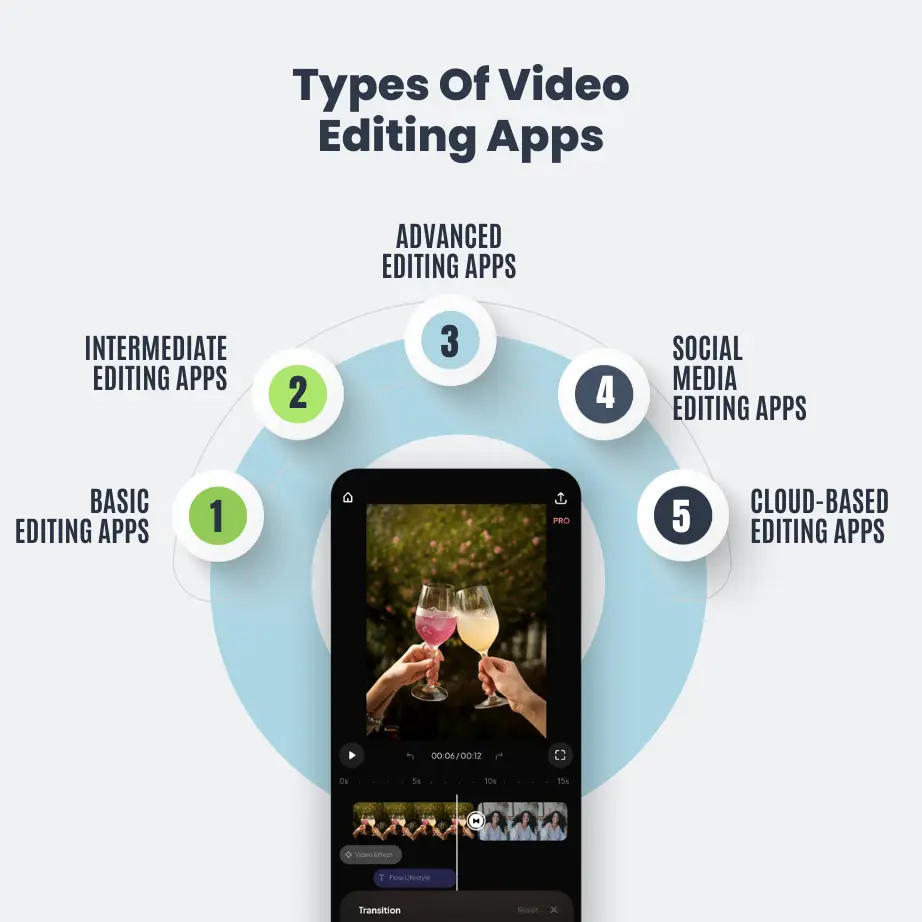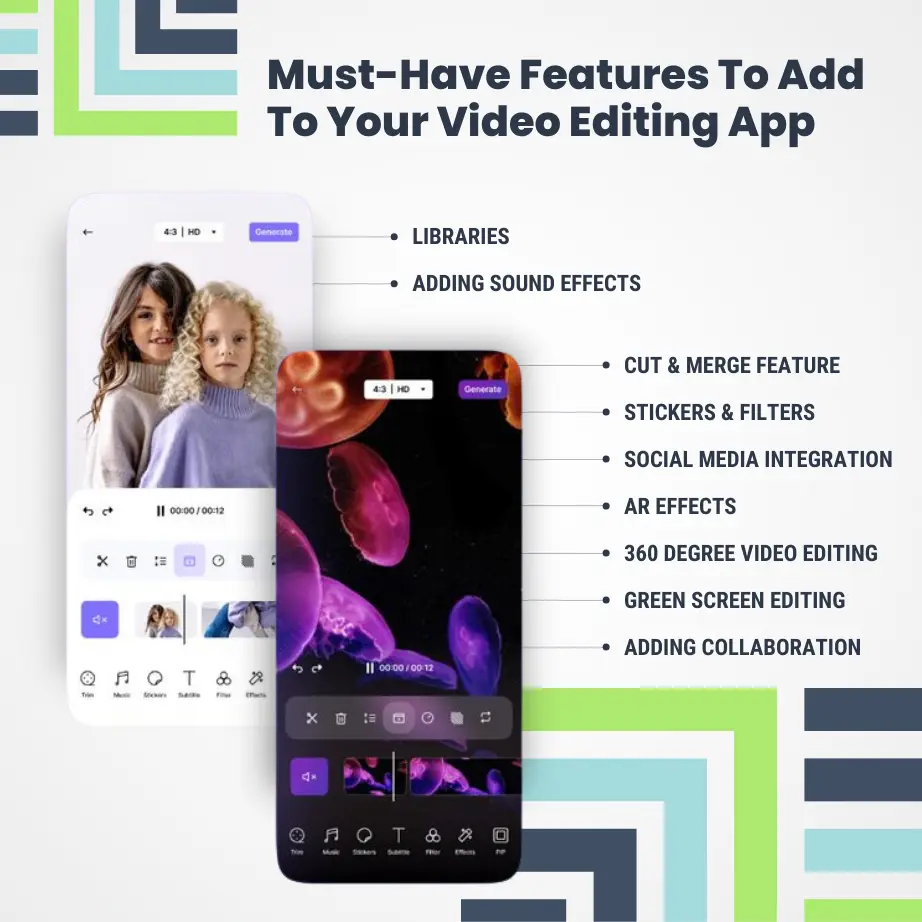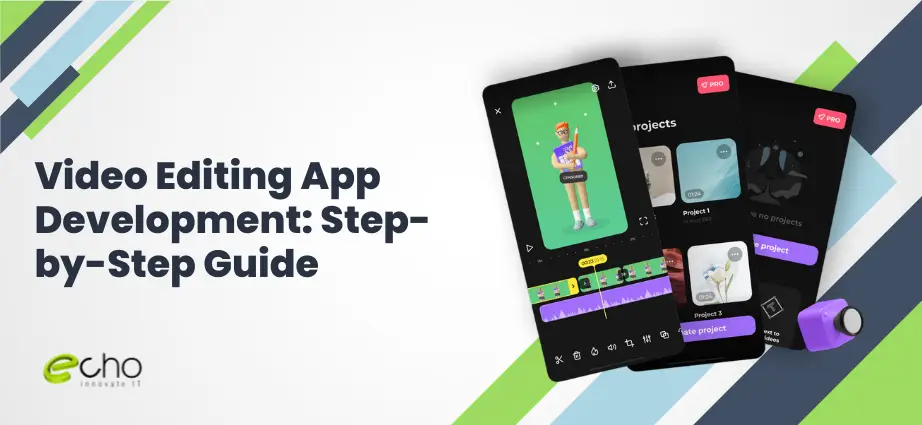Talking about video editing apps, they have grown in popularity in recent years, as more people create and share videos. Whether you’re a social media influencer, a filmmaker, or just a regular person wanting to edit your home films, having access to a competent video editing program can make a big impact.
With this thought, today’s blog will provide you with detailed knowledge of video editing app development and guide you in creating one for your business.
All You Need To Know About Video Editing Apps
A video editing app is a software application that allows users to edit, adapt, and enhance video footage with a variety of tools and capabilities. It has an easy-to-use interface that allows people of all skill levels to make visually stunning and engaging videos. These apps include a wide range of features, such as editing and cutting video clips, adding transitions and effects, altering colors and audio levels, overlaying text and images, and exporting the finished edited video in various formats.
Video editing apps enable users to import, edit, and export video files. This can include simple features like trimming, cropping, and altering video and audio levels. More complex features may include special effects, transitions, and the ability to insert text and graphics into the video.
Other significant capabilities of a video editing app include the ability to preview and playback modified video clips, as well as share the edited films on social media sites or store them on the user’s device. Now that we have understood the meaning of video editing apps, let’s know their different types.
Types Of Video Editing Apps

There are different types of video editing apps based on their type, complexity, and target audience. Some of them are mentioned below:
Basic Editing Apps
These programs are intended for casual users who wish to make quick adjustments to their films. They often include core functionality such as editing, chopping, and merging video clips, altering brightness and contrast, adding simple transitions, and applying rudimentary filters. Basic editing programs are simple to use and don’t require any technical knowledge.
Intermediate Editing Apps
Intermediate programs cater to customers who need more advanced editing skills. They offer more features than basic programs, like multi-track editing, audio mixing, keyframe animation, color correction, and complex transitions. These programs achieve a compromise between simplicity and flexibility, providing a broader set of editing capabilities.
Advanced Editing Apps
Advanced or professional editing suites are complete tools aimed at skilled videographers, filmmakers, and content providers. These apps include complex capabilities like multi-camera editing, motion tracking, chroma keying (green screen), advanced color grading, special effects, 3D editing, and high-quality audio editing. They offer comprehensive control and customization options for accurate video manipulation.
Social Media Editing Apps
Social media editing apps are intended for people who primarily generate material for social media sites. These apps frequently have built-in themes, filters, and effects specifically designed to improve videos for social sharing. They may also include capabilities such as direct sharing to popular platforms, video optimization for certain social media formats, and integrated analytics.
Cloud-Based Editing Apps
Cloud-based editing tools enable users to edit films online without the need for expensive hardware or software installations. These apps provide flexibility and collaboration features, allowing numerous users to work on the same project and access it from any device with an internet connection.
Why Should You Invest In Video Editing App Development
There are many reasons why you should invest in Video Editing Apps. It encompasses aspects like customer needs, market popularity, and what prospects indicate. Let’s understand some of the reasons why you need to invest in video editing apps:
Convenience and Accessibility
Smartphones are ubiquitous, widely available, and portable. With powerful CPUs and high-quality cameras, they provide a handy all-in-one solution for video capture, editing, and sharing. Users can edit films at any time and from any location, without the need for specialist equipment or specific editing facilities.
User-Friendly Interfaces and Applications
Video editing apps for smartphones have advanced tremendously, with intuitive UI and user-friendly capabilities. These apps are intended to appeal to a diverse spectrum of users, from beginners to pros, by providing streamlined editing workflows and a variety of creative tools.
Social Media and Content Development
The rise of social media platforms, combined with the demand for interesting content, has boosted the popularity of smartphone video editing. Users may simply modify movies and publish them on social media networks, reaching a larger audience and demonstrating their creativity.
Advances In Mobile Technology
Smartphones today include advanced hardware features such as strong processors, sufficient storage, and high-resolution displays. This technological advancement provides more seamless video editing experiences, including real-time previews and faster rendering speeds.
Also Read:
Expanding Community and Online Resources
The community of smartphone video editors has grown quickly, with online forums, tutorials, and tools freely available. Users can learn new skills, find inspiration, and share expertise with like-minded people, resulting in a thriving and supportive community.
Some Popular Examples Of Video Editing Apps
Adobe Premiere Rush
- It offers various editing tools, unlimited exports, and access to sounds and graphics who wish to try out video editing apps for free as beginners.
- Simple and easy user-friendly interface designed for those who have no prior video editing experience.
- It also has advanced features like cloud storage, multi-cam editing, and access to more premium content which you can get through an upgraded plan.
- Overall it’s a great app for beginners, social media creators, and content creators who like editing on various devices.
CapCut
- CapCut is a free, all-in-one video editing app available for iOS, Android, and Windows. It has a diverse set of capabilities, making it a popular choice for both new and seasoned video editors.
- It is also easy to learn and has and has a user-friendly interface with a wide range of tutorials and resources to get you started.
- It has a wide range of features like trimming, cutting, merging, splitting videos, etc.
- It’s free to use and requires no subscription model; best for those who are looking for budget-friendly video editing apps.
Also Read:
Davinci Resolve
- A professional-grade video editing tool without the price tag to match.
- A comprehensive collection of editing, color grading, audio mastering, and visual effects tools.
- An upgrade path for individuals who require more features.
LumaFusion
- LumaFusion is a highly regarded video editing application with a combination of powerful features, an intuitive interface, and a mobile-centric design.
- Mix audio tracks, add sound effects, and edit multiple videos and tracks simultaneously.
- Work seamlessly with cloud storage features like Google Drive and Dropbox.
Inshot
- Inshot is a great tool for beginners and content creators who are seeking a simple and efficient way to edit videos on the go.
- It heavily relies on visual cues and drag-and-drop functionality, simplifying the editing process.
- Cut and trim, adjust the length of your videos, and simply export final products in various formats and resolutions.
Must-Have Features To Add To Your Video Editing App

Here are some of the common features you can add to your video editing app. You don’t need to add all features to your app, you can customize them accordingly based on the type of app you are building – beginner-friendly or advanced level. Some of the basic features are mentioned here:
Libraries
Libraries are where users store their videos and photos after editing them. Libraries, in the context of mobile video editing, are simply the smartphone’s photo and video gallery. You can discover a means for your customers to import movies and photographs from their galleries, or you can provide the app with an integration that allows users to take films directly from their smartphone’s libraries.
Adding Sound Effects
A video editing app may allow users to add sound effects. The most straightforward method to implement this functionality would be to integrate a library of sound effects within the app. Again, if you are targeting more advanced customers, you may offer the option of importing their sound effects.
Cut & Merge Feature
Editing videos frequently entails using multiple videos as inputs. A little more complex function allows users to input multiple video files and trim and join them as desired.
Stickers & Filters
Enhance the visual attractiveness of produced videos by providing a variety of filters and stickers. These creative components enable viewers to personalize their videos and make them more interesting.
Social Media Integration
Integrating a social media function entails allowing users to post the films they generate with your app immediately on social media, without requiring too many steps.
AR Effects
Introduce augmented reality features that overlay virtual components onto real-world scenes in films. This feature adds a fun and interactive element to the editing process, allowing users to improve their movies with virtual objects or effects.
360 Degree Video Editing
Allows users to edit immersive 360-degree videos, ensuring an engaging viewing experience from any viewpoint. Improve their capacity to cut, merge, apply effects, and optimize these specialized videos.
Green Screen Editing
Unlock users’ creative potential by allowing them to smoothly replace the background of their movies with custom photos or films. This tool provides limitless options for storytelling and visual effects.
Adding Collaboration
Encourage teamwork and creativity by allowing users to collaborate via video. Users can communicate, share ideas, and contribute to video projects in real-time or asynchronously, which enhances the app’s social and collaborative features.
Developing A Video Editing App: Step-by-Step Process
Developing a video editing app is a comprehensive process that involves the support of the right developer’s team, in-depth research and observation, planning and execution, adding required technological stacks, and testing the apps at various levels. To help you understand the video editing app development process in a simplified manner, we have shortlisted some of the necessary steps you can follow to get clarity of the entire developmental process:
Make A Detailed Plan
In the early stages of the video editing program development, you start with an idea. You must nurture, examine, and fully define this concept to guarantee that it meets a specific demand or addresses a specific problem in the current market.
This is where your unique selling proposition (USP) comes into play. It might be anything from a new feature to an intuitive UI, improved performance, or pricing. USP gives potential consumers a compelling incentive to choose your software above competitors.
Confused How Much Cost It Will Take To Create A Video Editing App? Click The Below Link To Calculate Your Development Cost
Calculate Your Project NowChoose Monetization Models
When developing a video editing app, you might consider a variety of payment models:
Freemium: The app is free to download and use, but users can purchase premium features. This technique lets customers trial your software before opting to pay, lowering the barrier to entry.
In-app purchases: Users can purchase things or services within the app. For example, users may purchase sophisticated editing tools, special filters, or storage space.
Subscription: This strategy requires consumers to pay a recurring fee to access your video editing software app. It can be a good approach to produce consistent, predictable income.
Advertisements: You can generate cash by displaying advertising throughout your app.
Choosing The Required Technology Stack
Choosing the right tech stack is crucial for developing an outstanding video editing app. Check out some of the necessary stacks you need to add to your video editing app:
| Category | Services |
|---|---|
| Programming Languages | Swift, Objective (iOS) , Kotlin or Java (Android), JavaScript or Python (Backend) |
| Frameworks & Libraries | React Native or Flutter |
| Video Processing | FFmpeg or AVFoundation |
| Developmental Tools | Android Studio or Xcode or Visual Studio Code |
| Database | PostgreSQL, Kafka, DynamoDB |
| Testing | Spinnaker |
| Cloud Service | Hadoop, DRM Solution |
| Adding music & sound effects | MPMediaPickerController |
| Real-time analytics | Google Mobile Analytics, Hive, Localytics, Spark |
Add Backend Frameworks
The backend architecture of your video editing mobile app is comparable to the unseen tip of an iceberg. It is not immediately evident to users. However, it is necessary to maintain the app’s functionality, manage data, and provide a flawless UX.
Backend infrastructure includes server-side processes, databases, and application programming interfaces (APIs). It collaborates to provide features such as user authentication and video rendering, among others.
Test Your App
This step involves testing your app’s features and functionalities to guarantee they work as intended. With performance testing, you can evaluate your app’s performance under various scenarios, such as severe loads or stress. It’s critical to keep the app responsive and stable, especially when processing huge video files or during high usage. Initiate usability testing focusing on the user experience.
It determines whether the software is simple to use, intuitive, and matches users’ expectations. It frequently includes user testing sessions in which individuals use the app and give comments on their experience. Lastly, test compatibility to ensure your program runs seamlessly on several platforms, screen sizes, and orientations.
Deploy & launch Your App
It entails completing the necessary preparations for publishing your software on app stores such as Google Play for Android and the Apple Software Store for iOS apps.
Both Google and Apple have particular rules and guidelines that apps must follow. Furthermore, you must guarantee that your software is properly presented on the app store. It has a visually appealing app symbol, attractive screenshots, and a clear, persuasive explanation.
If you do not adhere to these standards and conditions, your application may be rejected throughout the review process. This delay may postpone the launch of your app and necessitate considerable revisions.
Cost of Developing A Video Editing App
The cost of developing a video editing app depends on various factors like the developer’s price, features, complexity of your application, software used, and time taken in the entire developmental process. You can count your average cost between USD 10,000 to USD 50,000 approximately.
Several factors affect the cost of video editing app development. It can depend on the choice of your platform (Android or iOS), design and development, added effects, and integration of third-party services. Let’s discuss them in brief:
Factors That Affect The Cost of Developing A Video Editing App
Set of Features
The complexity and scope of features you intend to include in your video editing software will have a big impact on development costs. Basic capabilities like video trimming, cropping, and filtering are less expensive to add than more complex functionalities like multi-track editing, special effects, motion graphics, green screen support, and AI-powered features.
Platform Compatibility
The fee depends on whether you wish to support iOS, Android, or both platforms. Developing for a single platform is typically less expensive than developing a cross-platform program, which must adapt to numerous operating systems, screen sizes, and platform-specific design requirements.
Backend Structure
Implementing a strong backend infrastructure to handle video processing, storage, rendering, and real-time collaboration features raises the development costs. The backend’s complexity, interaction with cloud storage providers, scalability needs, and the necessity for secure user accounts and data management all have an impact on cost.
Designing the User Interface (UI) and User Experience (UX)
Creating an appealing and intuitive UI/UX design for your video editing app takes careful attention. The cost varies depending on the complexity of the design, customization requirements, animation effects, and the necessity for a consistent and user-friendly experience across multiple devices and screen sizes.
Integration Of Third-Party Services
Integrating third-party libraries, APIs, or services might increase development costs. This involves integrating video hosting services, sharing social media, using analytics tools, and payment systems, and licensing third-party video effects or filters.
Conclusion
With the proper information and direction, you can build a strong tool that meets the ever-increasing need for video content creation and editing.
You may start your app development adventure successfully by following the steps indicated in this fast guide. To understand the current market needs, you can try using some popular video editing apps available out there and decide what type of application you are planning to build.
Develop A Custom Video Editing App With Echoinnovate IT
Designing a video editing app is fun and dynamic at the same time. It requires detailed attention at every step right from planning to the final testing phase. Planning to create a video editing app from scratch? Choosing the right app development company is essential for the success of your app. Bring your ideas to Echoinnovate IT and get a deep understanding of the video editing world from basic. Get tailored solutions that suit best for your business and receive cutting-edge solutions from our top experts.
Contact Us Today!
FAQs- Video Editing App Development
What is a video editing app?
A video editing app is software designed to manipulate and enhance video footage on mobile devices or computers. It typically includes features for trimming, adding effects, transitions, and exporting videos.
What platforms can video editing apps be developed for?
Video editing apps can be developed for various platforms including iOS, Android, and desktop operating systems like Windows and macOS.
What programming languages are commonly used for developing video editing apps?
Commonly used languages include Swift or Objective-C for iOS, Java or Kotlin for Android, and languages like C++ or JavaScript for cross-platform development.
How can I monetize my video editing app?
Monetization strategies can include offering a free app with in-app purchases for premium features, subscription models, displaying ads, or offering a one-time purchase for the app.



